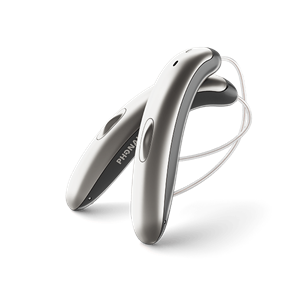In-the-Ear (ITE)
In the ear hearing aids can also mean the larger one-piece hearing devices pictured here. These aids fill the entire bowl of the ear and house all components in this single, custom-fitted piece.
Description
In-the-ear (ITE) hearing aids are a good option if you want an easy-to-handle device. The traditional ITE hearing aid come in different sizes, and are typically worn fully inside the ear or ear canal. These types of hearing aids can house many electronic features within one single case, providing room for more features including a telecoil, multiple directional microphones and more.
All the components are located inside a small shell. Volume can be adjusted and programs can be selected by remote control. Many models can be connected wirelessly to electronic devices such as mobile phones and TV sets.
Advantages
Discreet and barely visible from the outside
Suitable for people who wear glasses
More comfortable to wear during sports & activities
CIC models produce a natural sound because they utilize the characteristics of the concha
Disadvantages
Only suitable for those with mild or moderate hearing loss
Can create “plugged up” feeling
Susceptible to moisture
Use depends on the size of the ear canal
More than half of hearing care patients are good candidates for RIC hearing aids. If your loss is in the mild to moderately severe range and you have the ability to manipulate small objects, these hearing aids may be a good option for you.
The structure of ITE devices
All the components are located inside a small shell. This is inserted into the ear like an earplug. Some devices have an antenna-like plastic tab to ease removal. In-the-ear hearing aids are self-contained units. Volume can be adjusted and programs can be selected by remote control. Many models can be connected wirelessly to electronic devices such as mobile phones and TV sets.
Concha devices, which sit inside the concha.
Ear canal devices, which sit further inside the ear canal.
Completely invisible models: Completely-in-canal (CIC) devices.
Types of In-the-Ear Hearing Aids
In-the-Ear (ITE)
The housing of this hearing aid completely fills the concha. The advantages include a longerbatterylife, the availability of a power version for severe hearing loss, and improved operation.In-the-Canal (ITC)
This is a small and discreet custom model. The hearing aid housing sits in the ear canal, thus only filling half of the concha.Completely-in-Canal (CIC)
The smallest custom model, the CIC offers the ultimate in discretion as it is virtually invisible from the outside. These devices typically have a nylon strand to facilitate removal from the ear.Invisible-in-Canal (IIC)
This subgroup of CIC devices are hearing aids that are worn deep in the ear canal making them completely discreet. Phonak's Lyric is an example of an IIC hearing aid.VAC, WCB, WSIB, WorkSafeBC, ADP & ODSP accepted. *Hearing evaluations/tests are free for customers over the age of 18. Fees may apply where specific testing for employment purposes, reports, a copy of your results or the completion of an application is required. See clinic for full details.



